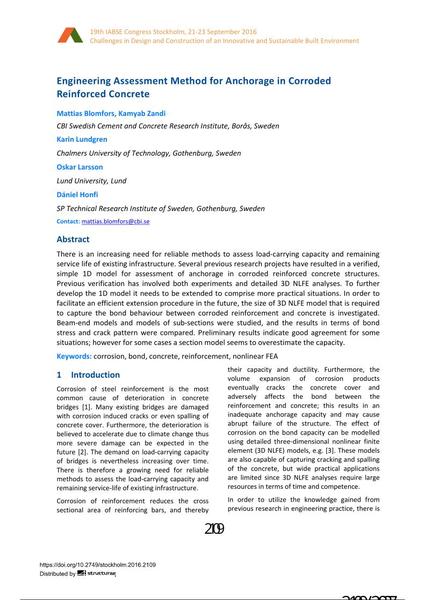Engineering Assessment Method for Anchorage in Corroded Reinforced Concrete

|
|
|||||||||||
Détails bibliographiques
| Auteur(s): |
Mattias Blomfors
(CBI Swedish Cement and Concrete Research Institute, Borås, Sweden)
Kamyab Zandi (CBI Swedish Cement and Concrete Research Institute, Borås, Sweden) Karin Lundgren (Chalmers University of Technology, Gothenburg, Sweden) Oskar Larsson (Lund University, Lund) Dániel Honfi |
||||
|---|---|---|---|---|---|
| Médium: | papier de conférence | ||||
| Langue(s): | anglais | ||||
| Conférence: | IABSE Congress: Challenges in Design and Construction of an Innovative and Sustainable Built Environment, Stockholm, Sweden, 21-23 September 2016 | ||||
| Publié dans: | IABSE Congress Stockholm, 2016 | ||||
|
|||||
| Page(s): | 2109-2116 | ||||
| Nombre total de pages (du PDF): | 8 | ||||
| Année: | 2016 | ||||
| DOI: | 10.2749/stockholm.2016.2109 | ||||
| Abstrait: |
There is an increasing need for reliable methods to assess load-carrying capacity and remaining service life of existing infrastructure. Several previous research projects have resulted in a verified, simple 1D model for assessment of anchorage in corroded reinforced concrete structures. Previous verification has involved both experiments and detailed 3D NLFE analyses. To further develop the 1D model it needs to be extended to comprise more practical situations. In order to facilitate an efficient extension procedure in the future, the size of 3D NLFE model that is required to capture the bond behaviour between corroded reinforcement and concrete is investigated. Beam-end models and models of sub-sections were studied, and the results in terms of bond stress and crack pattern were compared. Preliminary results indicate good agreement for some situations; however for some cases a section model seems to overestimate the capacity. |
||||
| Mots-clé: |
béton ferraillage
|
||||
